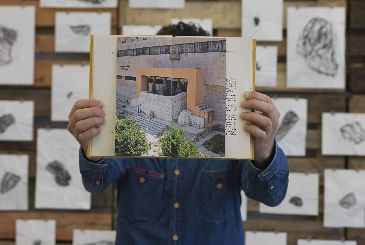Lebanon, Visual Arts, 2016
Rayyane
Tabet
Born in Ashquot in Lebanon in 1983, Rayyane Tabet studied Architecture at the Cooper Union, New York and Fine Art at University of California, San Diego. His (predominantly sculptural) works often address subjects from the modern history of the Republic of Lebanon, drawing on personal experience and memory as well as self-directed research.
‘FIRE / CAST / DRAW’ (2013) consists of approximately 10,000 unique lead objects, each cast according to an divining ritual known as ‘molybdomancy’ (or Bleigießen in German). The tradition, which dates back to ancient Greece, involves dropping molten tin or lead into cold water. The resulting metal forms may then be either interpreted as an omen for the future or used to create shadows that can be divined. Tabet’s sculpture makes reference to a belief that the lumps of lead bear the faces of people that have inflicted the evil eye curse within their abstract form. Produced using lead purchased from Lebanon’s last ammunition factory, it manifests an exhaustive ritual designed to ward off evil.
‘Cyprus’ (2015) is a sculpture employing a large found object – a partially rotted wooden boat – that is suspended above the ground, its weight balanced against a rusted anchor. Tabet’s father had rented the same boat in the 1980s, using it in an attempt to flee Lebanon for Cyprus, a journey that was abandoned after only 30 minutes. The work confronts a childhood memory of a situation that was only understood much later. This somewhat archaeological strategy of identifying an object or material to explore personal or collective memory can be seen elsewhere.
Several works refer to the Trans-Arabian Pipe Line (TAPLine), a joint venture by American oil companies that came together in 1946 to construct an oil pipeline in the Middle East. It was initially intended to facilitate the transport of petroleum between Dhahran in Saudi Arabia and Haifa – at that time in the British Mandate of Palestine – but was redirected to Sidon in Lebanon following the Partition Plan. Tabet has made a series of works that refer to the history of its construction and the subsequent dissolution of the company in 1983.
He has variously explored the pipeline’s physicality: its material construction, route and extent. An ongoing work begun in 2013 consists of steel rings constructed with the same thickness of steel and to the same diameter as the TAPLine. Installed upright at 10cm intervals along the gallery floor, each component of ‘Steel Rings’ is engraved with numbers representing the distance from the pipe’s source and its corresponding graphic coordinates. The sculpture is intended to ultimately manifest the full extent of the 1213km pipe. Similarly, ‘Mailroom Tags’ (1950 / 2013) redraws the route of the pipeline by sequencing the locations printed on 1916 of the company’s colour-coded paper labels that are suspended from a steelrod. Another work, ‘Chalk Line’ (2013) uses the string from two chalk line tools to plot the course of oil circulation before and after the introduction of the pipeline, creating an abstract, geometrical shape on the gallery wall. Other works explore the corporate history of the venture. ‘Three Logos’ (2013) simply reproduces the emblems of Caltex, Esso and Mobil – three petroleum companies involved in TAPLine – as a series of powder coated steel sculptures that are hung like mobiles from the gallery ceiling. ‘Letterhead’ (1950–2013) is an ‘abstracted timeline’ of documents found in the abandoned headquarters of TAPLine in Beirut. ‘Calendar’ (1975 – 2015) comprises the incomplete series of pages from a 1975 calendar that was found in the same place.
Tabet has been compared to an archaeologist in his approach, using the material remains of TAPLine to reconstruct and retell its history, believing that the company’s ‘shadow runs parallel to the shifts in land’ in the region. He maintains that ‘in disuse, the infrastructure is a measurement manifested in marks, objects and stories. These lines construct the present, and offer vantage points for perceiving the distances they define.’



